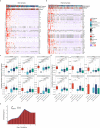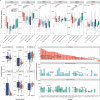This is a preprint.
Prolonged exposure to lung-derived cytokines is associated with inflammatory activation of microglia in patients with COVID-19
- PMID: 37546860
- PMCID: PMC10402123
- DOI: 10.1101/2023.07.28.550765
Prolonged exposure to lung-derived cytokines is associated with inflammatory activation of microglia in patients with COVID-19
Update in
-
Prolonged exposure to lung-derived cytokines is associated with activation of microglia in patients with COVID-19.JCI Insight. 2024 Mar 19;9(8):e178859. doi: 10.1172/jci.insight.178859. JCI Insight. 2024. PMID: 38502186 Free PMC article.
Abstract
Neurological impairment is the most common finding in patients with post-acute sequelae of COVID-19. Furthermore, survivors of pneumonia from any cause have an elevated risk of dementia1-4. Dysfunction in microglia, the primary immune cell in the brain, has been linked to cognitive impairment in murine models of dementia and in humans5. Here, we report a transcriptional response in human microglia collected from patients who died following COVID-19 suggestive of their activation by TNF-α and other circulating pro-inflammatory cytokines. Consistent with these findings, the levels of 55 alveolar and plasma cytokines were elevated in a cohort of 341 patients with respiratory failure, including 93 unvaccinated patients with COVID-19 and 203 patients with other causes of pneumonia. While peak levels of pro-inflammatory cytokines were similar in patients with pneumonia irrespective of etiology, cumulative cytokine exposure was higher in patients with COVID-19. Corticosteroid treatment, which has been shown to be beneficial in patients with COVID-196, was associated with lower levels of CXCL10, CCL8, and CCL2-molecules that sustain inflammatory circuits between alveolar macrophages harboring SARS-CoV-2 and activated T cells7. These findings suggest that corticosteroids may break this cycle and decrease systemic exposure to lung-derived cytokines and inflammatory activation of microglia in patients with COVID-19.
Conflict of interest statement
Conflict of Interest Statement B.D.S. holds US patent 10,905,706, “Compositions and methods to accelerate resolution of acute lung inflammation,” and serves on the scientific advisory board of Zoe Biosciences, in which he holds stock options. The other authors declare no conflicts of interest.
Figures




References
Publication types
Grants and funding
- R01 HL153122/HL/NHLBI NIH HHS/United States
- R21 AG075423/AG/NIA NIH HHS/United States
- S10 OD011996/OD/NIH HHS/United States
- U19 AI135964/AI/NIAID NIH HHS/United States
- P01 HL154998/HL/NHLBI NIH HHS/United States
- U01 TR003528/TR/NCATS NIH HHS/United States
- R01 LM013337/LM/NLM NIH HHS/United States
- R01 HL147290/HL/NHLBI NIH HHS/United States
- T32 HL076139/HL/NHLBI NIH HHS/United States
- I01 CX001777/CX/CSRD VA/United States
- R01 ES034350/ES/NIEHS NIH HHS/United States
- R01 ES027574/ES/NIEHS NIH HHS/United States
- P01 AG049665/AG/NIA NIH HHS/United States
- R01 HL153312/HL/NHLBI NIH HHS/United States
- UL1 TR001422/TR/NCATS NIH HHS/United States
- T32 AG020506/AG/NIA NIH HHS/United States
- R01 HL158139/HL/NHLBI NIH HHS/United States
- P30 CA060553/CA/NCI NIH HHS/United States
- F31 AG071225/AG/NIA NIH HHS/United States
- R01 HL149883/HL/NHLBI NIH HHS/United States
LinkOut - more resources
Full Text Sources
Miscellaneous
